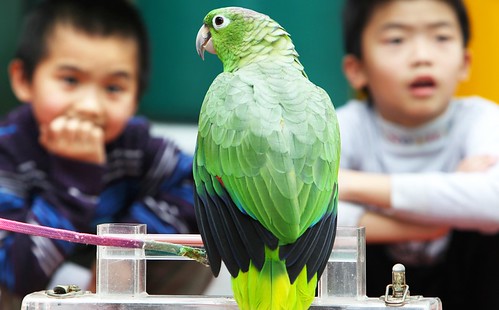 A 10-year-old Amazon Parrot Ka at the Pei Tau Village Playground, Sha Tin. Photo: Dickson LeeHKU researchers discover bird bug that may have indirectly led to six animal quarantine staff being hospitalised with lung infections.
A 10-year-old Amazon Parrot Ka at the Pei Tau Village Playground, Sha Tin. Photo: Dickson LeeHKU researchers discover bird bug that may have indirectly led to six animal quarantine staff being hospitalised with lung infections.
University of Hong Kong researchers have identified a previously unknown virus in parrots that may have helped a separate disease cross over into humans, sending six staff members at an animal quarantine centre to hospital with lung infections.
Their investigation may also shed light on why some common animal diseases suddenly become more dangerous to humans, according to the man who led the study, HKU's head of microbiology Professor Yuen Kwok-yung. The findings were published in the journal PLoS Neglected Tropical Diseases.
Yuen's team began an investigation in November 2012, when six workers at the New Territories North animal management centre in Sheung Shui became ill and were admitted to hospital with respiratory tract infections after handling parrots in quarantine.
They were later discovered to have Chlamydophila psittaci, a common bacterium found in 60 per cent of tropical birds but which only occasionally crosses over to humans in a small scale.
"We felt that it was unusual for Chlamydophila psittaci to have infected so many people," Yuen said. "This is why we started looking for other reasons for the disease to behave so abnormally."
The researchers studied eight of the 16 mealy parrots from South America that were being kept in the centre. They found the parrots were infected with both Chlamydophila psittaci and a virus never before identified anywhere in the world. The newly discovered virus has been named Psittacine adenovirus HKU1, after the university.
The study found that birds with a higher load of the adenovirus also carried more Chlamydia psittaci bacteria. Yuen believes the virus weakened the immune systems of the birds, allowing the production of an unusually high level of Chlamydophila psittaci - enough to cause an outbreak in humans.
Yuen is one of the world's premier virus fighters. He was named an Asian hero by Time magazine for his work in fighting the 2003 severe acute respiratory syndrome outbreak and his team later helped track how the virus that caused Sars passed from bats to humans via civet cats.
He said the latest finding had sparked a new concept in researching why some common diseases could suddenly turn more threatening.
In this case, all of the infected humans recovered. Of the 16 birds, two died naturally while 14 grew sick and were put to sleep.
Microbiologist Dr Kelvin To Kai-wang, who co-led the study with Yuen, believes the new virus does not present a direct risk to public health, as it was not detected in the human patients.
To believes the newly identified virus may also be found in other parrots from South America, as well as wild birds.
Yuen said it had sparked a new direction for research as the microbe behind the unusual outbreak may be linked to other novel viruses.